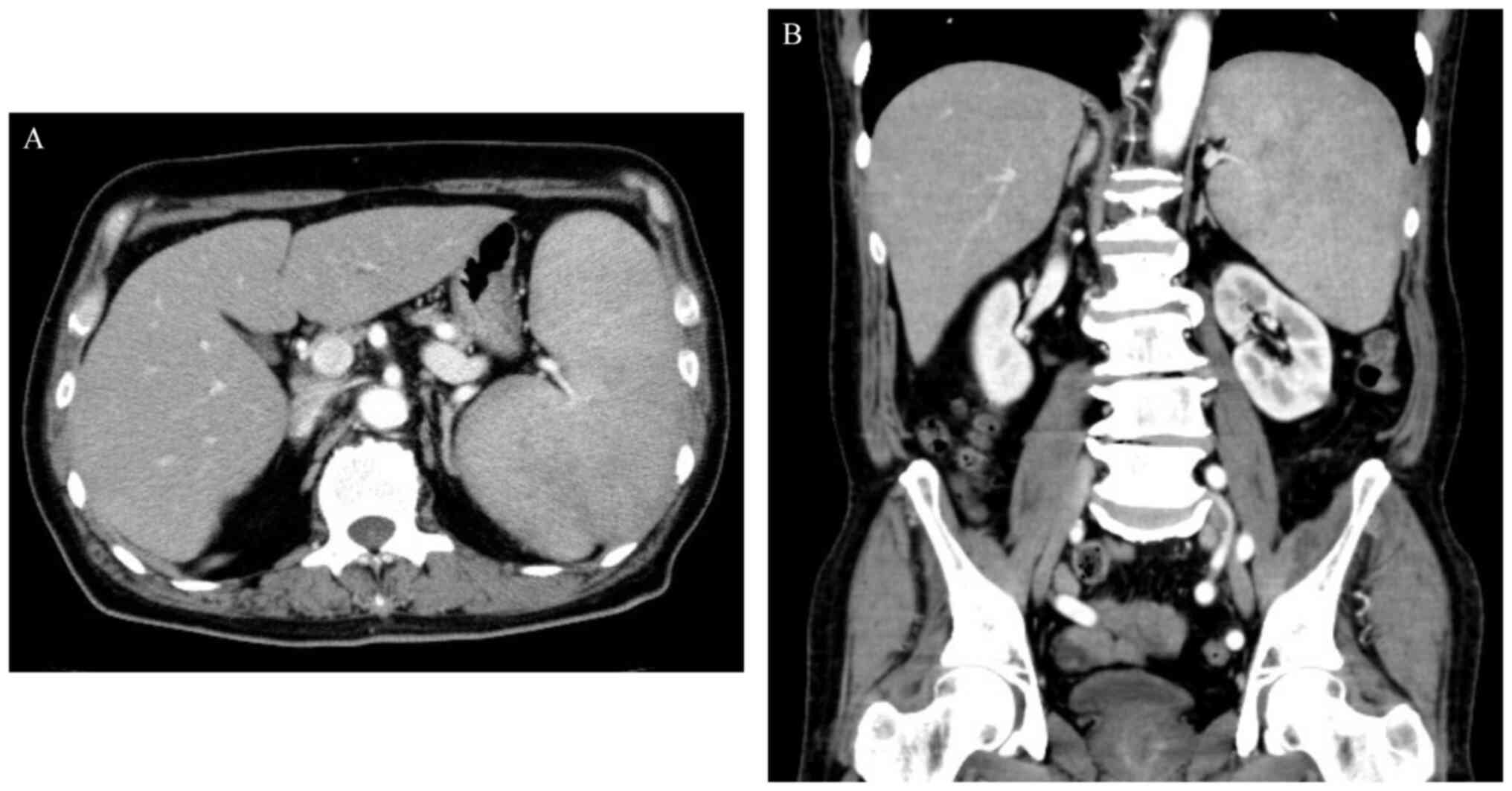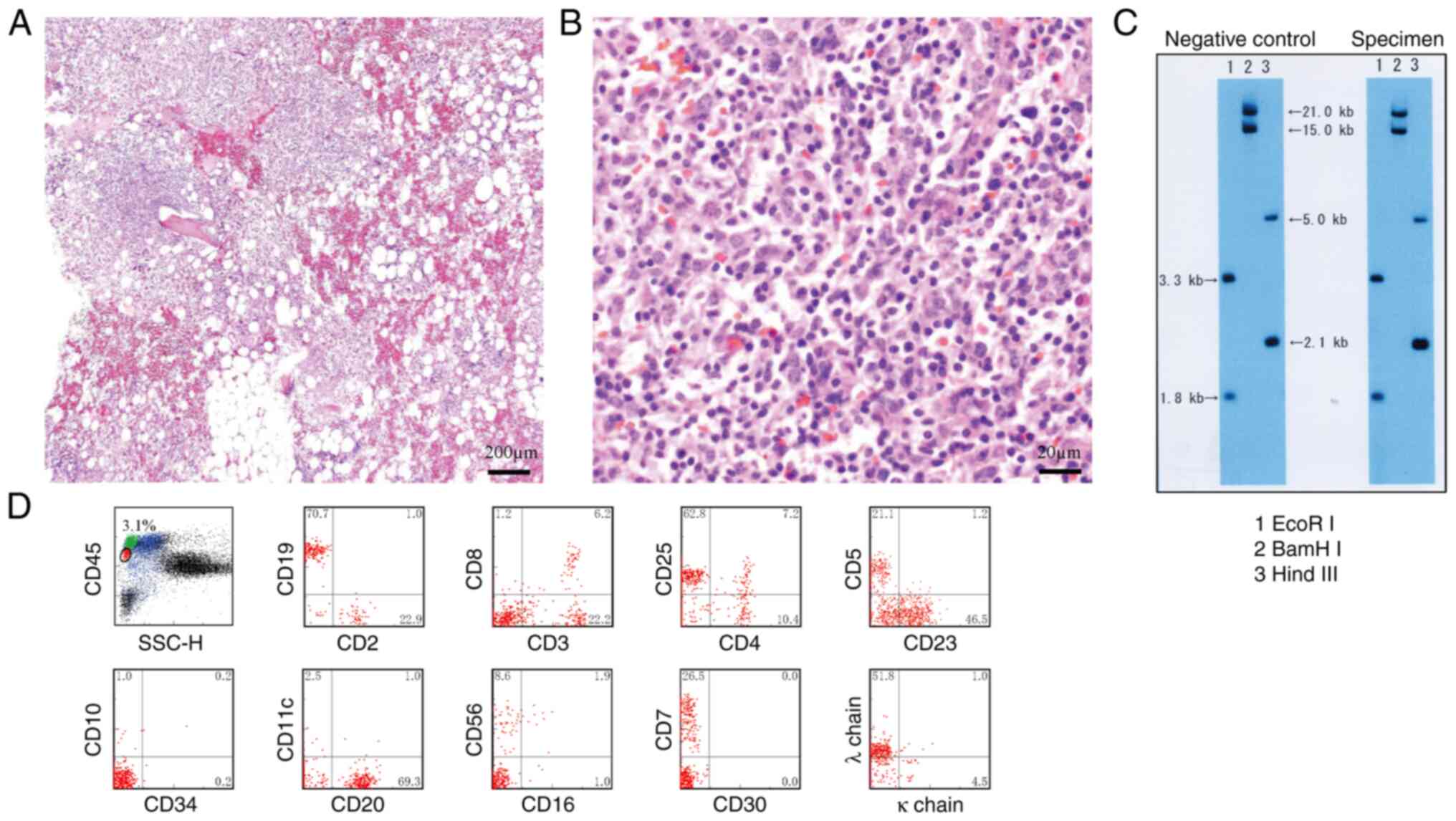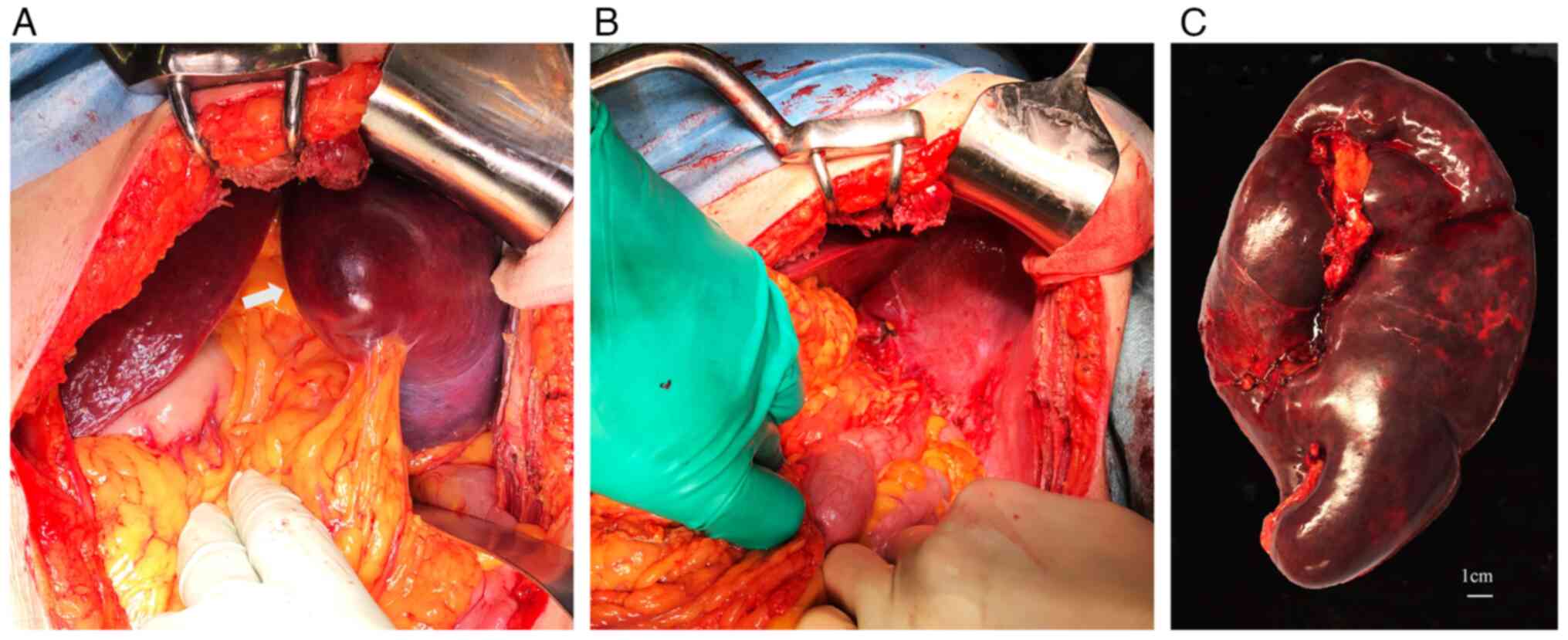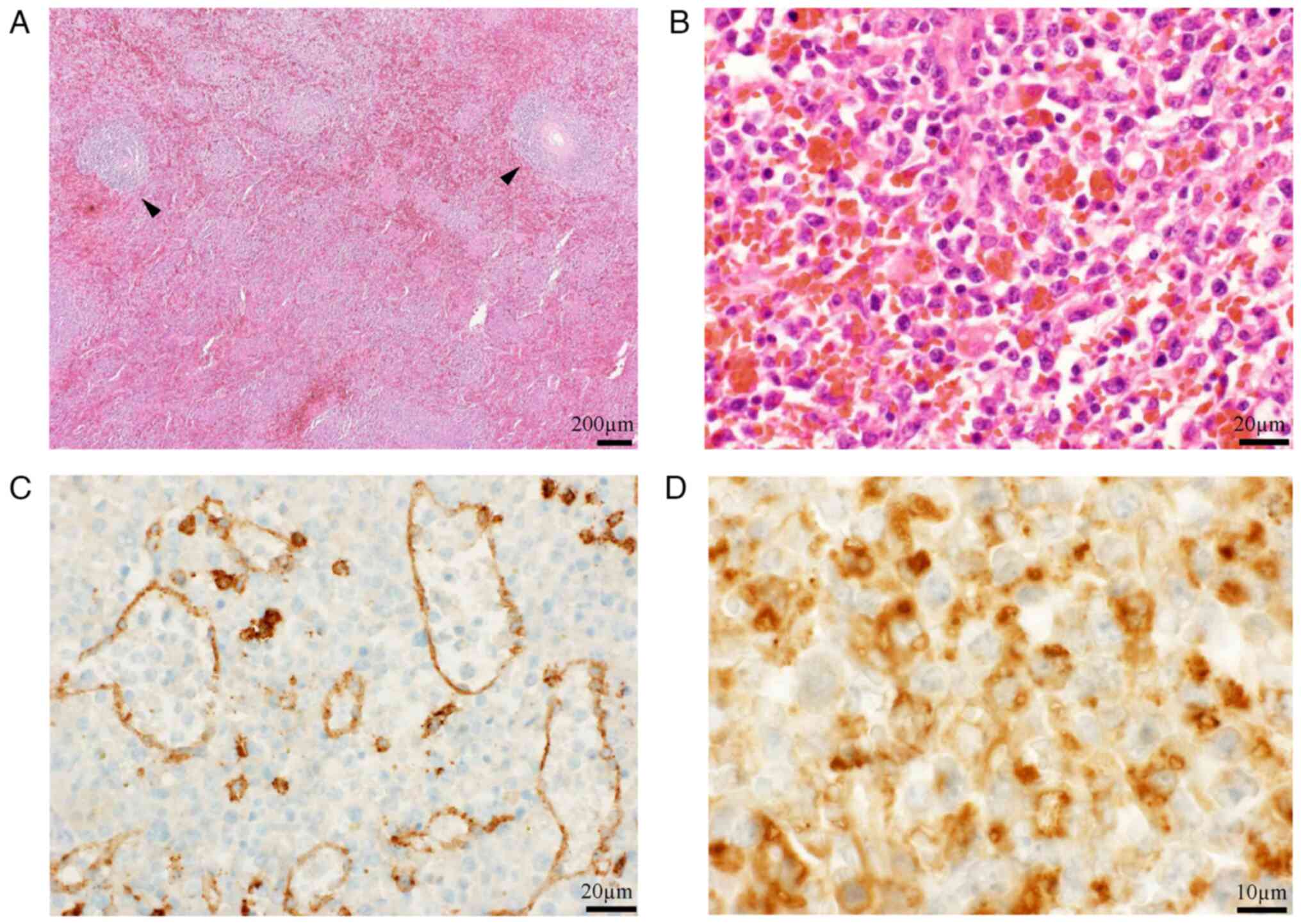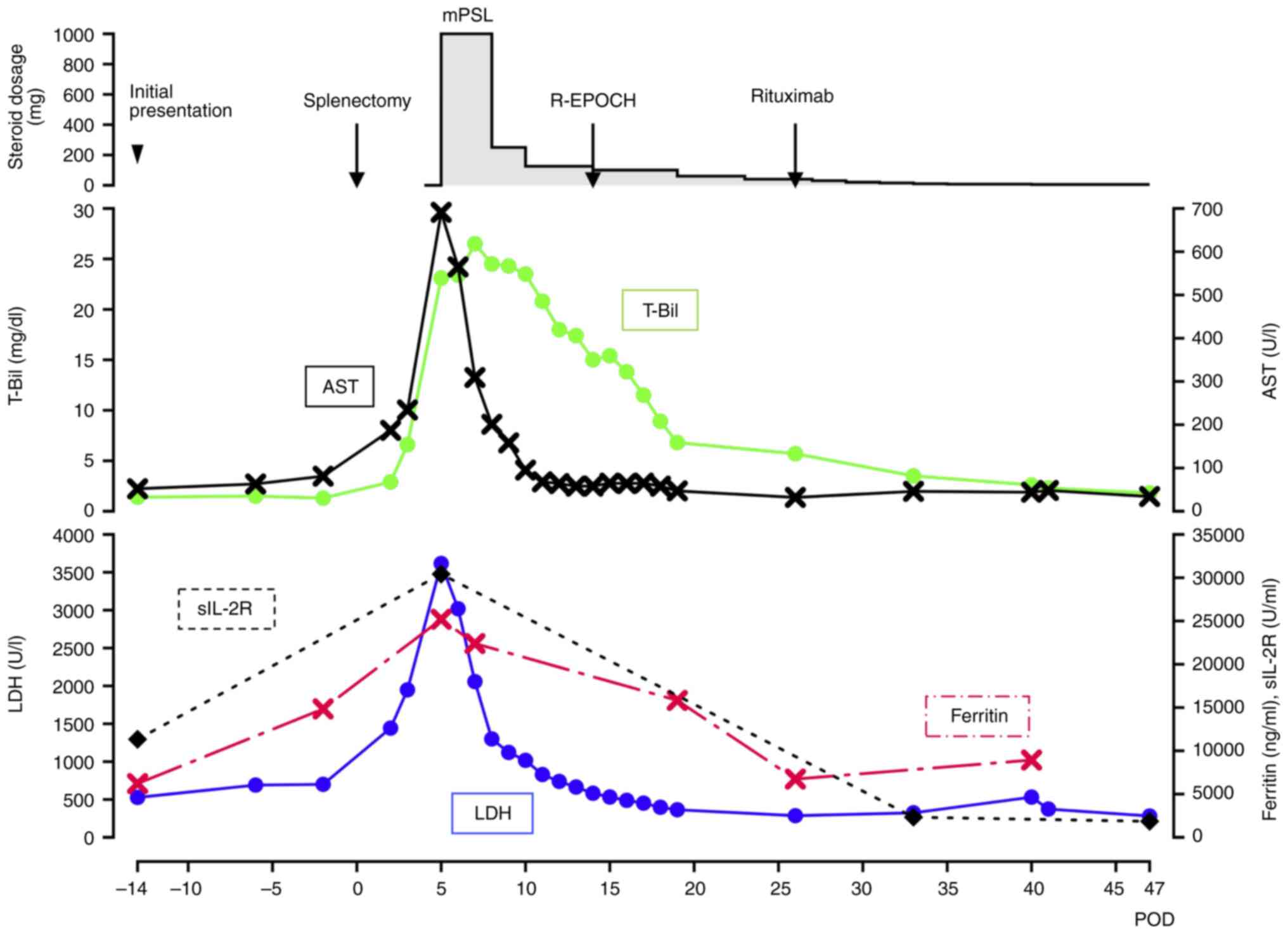Successful treatment of severe splenic lymphoma‑associated hemophagocytic syndrome by splenectomy and subsequent chemotherapy: A case report
- Authors:
- Published online on: March 22, 2024 https://doi.org/10.3892/ol.2024.14355
- Article Number: 222
-
Copyright: © Masui et al. This is an open access article distributed under the terms of Creative Commons Attribution License.
Abstract
Introduction
Hemophagocytic lymphohistiocytosis (HLH), also termed ‘hemophagocytic syndrome’ or ‘macrophage activation syndrome’, is a life-threatening condition characterized by pathological inflammatory responses (1). Clinical manifestations of HLH include recurrent fever, cytopenia, splenomegaly and sepsis-like syndrome, potentially culminating in multiple organ failure (MOF). HLH is classified into primary and secondary forms. Primary HLH is a hereditary condition predominantly observed in pediatric populations. Secondary HLH stems from malignancies, autoimmune diseases or idiopathic causes (2). Although numerous malignancies can accompany HLH, lymphoma-associated hemophagocytic syndrome (LAHS) is particularly prevalent. Malignant lymphoma is categorized into low-grade and high-grade lymphoma. It is worth noting that LAHS can manifest as a symptom of high-grade lymphoma rather than low-grade lymphoma (3,4) and is associated with poor prognosis (5). Although LAHS is usually treated with corticosteroid therapy and cytotoxic chemotherapy for lymphoma (6), the significance of surgical intervention remains unclear, as no surgical cases have been reported to date.
The present study described a challenging case of lymphoma-associated splenomegaly, which led to severe HLH following splenectomy. It was possible to save the patient through timely splenectomy to reduce the tumor burden, enabling safe and effective steroid pulse therapy and chemotherapy.
Case report
A 71-year-old man with a medical history of hypertension and hyperuricemia presented to the primary hospital, Japan Baptist Hospital's Department of Internal Medicine (Kyoto, Japan), with fatigue and anorexia in February 2023. Laboratory test results revealed anemia [hemoglobin (Hb), 10 g/dl; normal range, 12–16 g/dl], thrombocytopenia [platelet count (Plt), 100×103/µl; normal range, 150–450×103/µl], elevated lactate dehydrogenase levels (LDH, 627 U/l; normal range, 140–271 U/l) and a markedly elevated ferritin level (6,210 ng/ml; normal range, 15–500 ng/ml). In addition, the patient's soluble interleukin 2 receptor (sIL-2R) level was significantly increased at 11,328 U/ml (normal range, 122–496 U/ml). Abdominal computed tomography (CT) revealed splenomegaly, without enlarged lymph nodes (Fig. 1). 18F-fluorodeoxyglucose-positron emission tomography (FDG-PET)/CT showed the most pronounced increased uptake of FDG in the spleen, followed by the right atrium and the bone marrow (Fig. 2). The bone marrow biopsy identified an increase in small lymphocytes with occasional large cells on Hematoxylin and Eosin (HE) staining (7) (Fig. 3A and B). Clonality was confirmed through cytogenetic examination of T cell receptor γ chain Jγ rearrangement (8,9) using Southern blot analysis (10) with restriction enzymes EcoRI, BamHI and HindIII (Takara Bio, Inc.) (Fig. 3C).In addition, clonality was supported by flow cytometric analysis with CD45 gating (11) (Fig. 3D). Flow cytometry utilized a panel of pre-diluted antibodies from BD Biosciences, including CD45 (PerCP) (cat. no. 347464), CD2 (FITC) (cat. no. 347593), CD19 (BV421) (cat. no. 562440), CD3 (PE) (cat. no. 347347), CD8 (BV510) (cat. no. 563919), CD4 (APC-H7) (cat. no. 641398), CD25 (BV421) (cat. no. 562442), CD5 (FITC) (cat. no. 347303), CD23 (BV421) (cat. no. 562707), CD10 (PE) (cat. no. 340921), CD20 (APC-H7) (cat. no. 641396), CD11c (BV510) (cat. no. 563026), CD16 (BV510) (cat. no. 563830), CD56 (APC) (cat. no. 341025), CD30 (FITC) (cat. no. 341644), CD7 (APC) (cat. no. 561604), kappa light chains (PE) (cat. no. 346601), and lambda light chains (APC-H7) (cat. no. 656648), all used according to the manufacturer's protocol; however, a definitive diagnosis of the histological subtype could not be established.
Despite the abnormal laboratory data, the patient's activities of daily living were relatively preserved. After comprehensive assessment under outpatient conditions, elective surgery was planned to obtain a histological diagnosis two weeks after the initial presentation. On admission, 2 days preoperatively, the patient exhibited a spike fever of 39°C and progressive cytopenia (Hb, 8.6 g/dl; and Plt, 62×103/µl) was observed. The next day (the day before surgery), 20 units of platelet concentrate were transfused, but the Plt count had dropped to 55×103/µl on the operative day. Due to the patient's significant splenomegaly, laparotomy was selected instead of laparoscopy. Splenectomy was eventually performed via a left subcostal incision (Fig. 4A). The procedure involved the separate ligation of the splenic artery and vein, and the spleen was extracted by stapling the tail of the pancreas at the splenic hilum (Fig. 4B). The operation lasted for 100 min, with an estimated blood loss of 600 ml. The excised specimen weighed 1,100 g (Fig. 4C). Subsequent histological examination confirmed the diagnosis of low-grade B-cell lymphoma with focal transformation to high-grade lymphoma with severe hemophagocytosis on HE staining (7) (Fig. 5). To confirm red-pulp, but not white-pulp, involvement of the lymphoma, immunohistochemistry was performed using an anti-CD8 antibody (cat. no. M7103; DAKO) at a dilution of 1:100, and Bentana ultraView DAB universal kit (Roche Diagnostics) for identification of sinus endothelial cells according to the manufacturers' standard protocols. The lymphoma predominantly involved the red pulp with some remaining atrophic white pulp, and the histological diagnosis was immunohistochemically confirmed using a CD68 probe (cat. no. NCL-CD68-KP1; Novocastra) at a dilution of 1:400 (Fig. 5). Thus, splenic marginal-zone lymphoma (commonly seen in this organ) could not be included in the histologic differential diagnosis; the lymphoma was finally characterized as unclassifiable. The patient was diagnosed with stage IVB disease according to the Ann Arbor Classification System (12).
Despite having undergone surgery, the pre-existing symptoms of intermittent fever and fatigue did not improve postoperatively. The patient exhibited low blood pressure and required temporary dopamine administration. On postoperative day (POD) 3, a rapid decrease in the Plt count (62×103/µl) and elevation in LDH (1,948 U/l), aspartate aminotransferase (AST) (234 U/l; normal range, 8–48 U/l), total bilirubin (T-Bil) (6.6 mg/dl; normal range, 0.3–1.2 mg/dl), direct bilirubin (D-Bil) (4.5 mg/dl; normal range, 0.0–0.3 mg/dl) and C-reactive protein (CRP) levels (18.56 mg/dl; normal range, <0.5 mg/dl) were observed (Fig. 6). CT scanning did not detect any postoperative complications, such as pancreatic leakage. To exclude the possibility of drug-induced liver damage or potential embolism, medication adjustments were made and heparin was administered. However, the patient's condition further deteriorated.
Consequently, the patient was transferred to a tertiary care institution on POD 5, where he was admitted to the intensive care unit (ICU). Laboratory reassessment revealed the following abnormalities: Decrease in Hb (8.3 g/dl) and Plt (47×103/µl); and significant elevations in LDH (3,616 U/l), AST (691 U/l), alanine aminotransferase (112 U/l; normal range, 7–55 U/l), T-Bil (21 mg/dl), D-Bil (17 mg/dl), creatinine (1.77 mg/dl; normal range, 0.5–1.2 mg/dl), CRP (23.44 mg/dl), ferritin (25,197 ng/ml) and sIL-2R (30,420 U/ml). The patient also exhibited hypoglycemia, with a blood glucose level of 25 mg/dl (normal range: 70–99 mg/dl), indicative of hepatic failure. However, since coagulation markers, such as prothrombin time and activated partial thromboplastin clotting time, were normal, plasma exchange therapy was deemed unnecessary (13).
The diagnosis of concurrent HLH was made and treatment with immunosuppressive therapy, steroid pulse therapy at 1,000 mg/day for 3 days, was immediately initiated under mechanical ventilation and continuous hemodiafiltration. Following this intervention, liver dysfunction was gradually ameliorated; the steroid dosage was tapered down (Fig. 6). The patient was extubated on POD 12 and subsequent chemotherapy for lymphoma with the R-EPOCH regimen (Rituximab, Etoposide, Prednisone, Oncovin, Cyclophosphamide and Hydroxydaunorubicin) was initiated on POD 14. Considering the hepatic dysfunction and tumor load, the initial dose of the regimen was reduced to 50%, and the administration of rituximab was delayed until POD 26. Bradycardia with a heart rate of 40 beats/min was transiently observed, presumably due to the infiltration of lymphoma into the sinoatrial node (Fig. 2B). However, there was no need for the placement of a pacemaker. After chemotherapy initiation, this bradycardia gradually improved, and further improvements in liver function were observed. The patient was discharged from the ICU on POD 23 and hemodialysis was discontinued on POD 30.
After experiencing gastric ulcer bleeding on POD 19 and acute pancreatitis on POD 27 as complications of steroid treatment, which were successfully managed with hemostasis and endoscopic drainage, a second course of R-EPOCH therapy was initiated on POD 77. After the patient's condition stabilized, he was transferred back to our primary hospital on POD 93 and was discharged home on POD 168. At eight months after the onset, the patient remains alive with improved performance status and his treatment is ongoing, specifically continuing with consolidation therapy for lymphoma. He is undergoing outpatient consultations with a frequency of approximately once every two weeks.
Discussion
HLH comprises a spectrum of conditions driven by uncontrolled inflammatory reactions. Among secondary HLH, malignancy-related HLH is predominantly associated with non-Hodgkin lymphomas. Of note, LAHS demonstrates a dismal prognosis with an average survival of only 37 days after treatment initiation (5), and this condition has been extensively studied (14,15). LAHS is itself a fatal condition, which often results in death despite intensive treatment with corticosteroid pulse therapy and cytotoxic chemotherapy (4,16–20).
Splenomegaly, or an increased standardized uptake value on FDG-PET, is a frequent manifestation of numerous hematological disorders, including malignant lymphomas (21). An enlarged spleen may act as a reservoir for malignant cells, potentially accelerating disease progression. Splenectomy can alleviate related symptoms, such as abdominal discomfort and cytopenia, while allowing for diagnosis based on histopathological examination. This procedure may also offer therapeutic benefits, particularly in cases of B-cell splenic lymphoma (22–24). There is a distinct subset of HLH cases of unknown etiology that poses a clinical challenge. In such cases, splenectomy has been shown to serve as an effective diagnostic and therapeutic strategy (25–27), while a clinical trial is currently underway to validate its efficacy (NCI02862054). It can be inferred from these observations that the role of splenectomy in the context of splenic lymphoma and secondary HLH of idiopathic etiology has been established.
Malignant HLH is associated with MOF, leading to high rates of morbidity and mortality. In the present case, the preoperative progressive decrease in Hb and Plt indicates that signs of MOF were already present. If only chemotherapy had been administered without surgical intervention, there would have been a potential risk of triggering a severe tumor lysis syndrome and exacerbating pre-existing HLH due to the high tumor burden (28). Therefore, without splenectomy, the patient may have experienced more disastrous outcomes, such as the progression of MOF, splenic rupture (29), and even death. Retrospectively, the splenectomy did have a role in reducing the tumor burden, which in turn facilitated safer and more effective chemotherapy.
However, a critical question remains in the present case: Despite the removal of a significant tumor mass, why did the patient still develop severe HLH? Based on the postoperative course of the case, it is evident that surgery alone failed to halt the development of HLH, with hypotension observed postoperatively, suggesting a concurrent cytokine storm. Initially, it was assumed that his splenic lymphoma was primarily indolent. However, highly elevated ferritin levels at the presentation suggested the presence of HLH preoperatively. Pathological findings of the spleen supported this, further revealing high-grade lymphoma transformation. There is a high likelihood that the acute transformation occurred immediately before surgery. On the other hand, the widespread progression of HLH may have resulted from several factors during the surgical procedure: The surgical stimulation could have activated the lymphoma cells to secrete large amounts of soluble factors, such as TNF-α (30), or the operative procedure may have dispersed cellular components into the systemic circulation (31).
The HLH-2004 diagnostic criteria are well-known (2). However, adult patients may exhibit symptoms that are difficult to distinguish from sepsis or MOF of other causes. Delayed diagnosis of LAHS may have fatal consequences (17,18). Currently, no standardized treatment strategy exists, and whether an HLH-directed or malignancy-directed approach should be adopted (32,33) remains unclear. In the case of the present study, upon his transfer to a tertiary hospital on POD 5, the patient met 6 of the 8 HLH-2004 diagnostic criteria, leading to the identification of his condition. Finally, immunosuppressive therapy preceded, stabilizing the patient's condition and allowing us to commence chemotherapy. At the time of conclusion of the present study, eight months postoperatively, the patient has achieved a longer survival than typical reported cases.
In conclusion, while splenic lymphoma typically manifests with low-grade lymphoma, it can transform into a high-grade lymphoma, which can accompany severe complications such as HLH and MOF. In the present case, splenectomy served not only in the diagnosis but also in tumor cytoreduction before chemotherapy. Furthermore, through interdisciplinary collaboration between the surgical and hematology teams, the patient's condition was successfully treated by performing a timely splenectomy to reduce the tumor burden, followed by steroid pulse therapy and chemotherapy. Of note, surgery and subsequent chemotherapy may be life-saving in certain cases of LAHS, as this strategy may assist in avoiding chemotherapy-related fatal complications.
Acknowledgements
Not applicable.
Funding
Funding: No funding was received.
Availability of data and materials
The datasets used and/or analyzed during the current study are available from the corresponding author upon reasonable request.
Authors' contributions
HM, KO and KK participated in the surgical procedures. MSh, YI, AU, MSu, TS and KK were involved in clinical management. HM drafted the manuscript. MSh, YI, AU, MSu, TS, KO and KK revised the manuscript for important intellectual content. All the authors have read and approved the final manuscript. HM and KK have independently reviewed and confirm all the raw data.
Ethics approval and consent to participate
Not applicable.
Patient consent for publication
Written informed consent was obtained from the patient for the publication of this case report and the accompanying images.
Competing interests
The authors declare that they have no competing interests.
Glossary
Abbreviations
Abbreviations:
|
HLH |
hemophagocytic lymphohistiocytosis |
|
MOF |
multiple organ failure |
|
LAHS |
lymphoma-associated hemophagocytic syndrome |
|
Hb |
hemoglobin |
|
Plt |
platelet count |
|
LDH |
lactate dehydrogenase |
|
sIL-2R |
soluble interleukin 2 receptor |
|
CT |
computed tomography |
|
FDG-PET |
18F-fluorodeoxyglucose-positron emission tomography |
|
HE |
Hematoxylin and Eosin |
|
POD |
postoperative day |
|
AST |
aspartate aminotransferase |
|
T-Bil |
total bilirubin |
|
D-Bil |
direct bilirubin |
|
CRP |
C-reactive protein |
|
ICU |
intensive care unit |
|
R-EPOCH |
Rituximab, Etoposide, Prednisone, Oncovin, Cyclophosphamide and Hydroxydaunorubicin |
|
SUV |
standardized uptake value |
|
mPSL |
methylprednisolone |
References
|
La Rosée P, Horne A, Hines M, von Bahr Greenwood T, Machowicz R, Berliner N, Birndt S, Gil-Herrera J, Girschikofsky M, Jordan MB, et al: Recommendations for the management of hemophagocytic lymphohistiocytosis in adults. Blood. 133:2465–2477. 2019. View Article : Google Scholar : PubMed/NCBI | |
|
Henter JI, Horne A, Aricó M, Egeler RM, Filipovich AH, Imashuku S, Ladisch S, McClain K, Webb D, Winiarski J and Janka G: HLH-2004: Diagnostic and therapeutic guidelines for hemophagocytic lymphohistiocytosis. Pediatr Blood Cancer. 48:124–131. 2007. View Article : Google Scholar : PubMed/NCBI | |
|
Lee JC and Logan AC: Diagnosis and management of adult malignancy-associated hemophagocytic lymphohistiocytosis. Cancers (Basel). 15:18392023. View Article : Google Scholar : PubMed/NCBI | |
|
Pasvolsky O, Zoref-Lorenz A, Abadi U, Geiger KR, Hayman L, Vaxman I, Raanani P and Leader A: Hemophagocytic lymphohistiocytosis as a harbinger of aggressive lymphoma: A case series. Int J Hematol. 109:553–562. 2019. View Article : Google Scholar : PubMed/NCBI | |
|
Li F, Li P, Zhang R, Yang G, Ji D, Huang X, Xu Q, Wei Y, Rao J, Huang R and Chen G: Identification of clinical features of lymphoma-associated hemophagocytic syndrome (LAHS): An analysis of 69 patients with hemophagocytic syndrome from a single-center in central region of China. Med Oncol. 31:9022014. View Article : Google Scholar : PubMed/NCBI | |
|
Wang H, Xiong L, Tang W, Zhou Y and Li F: A systematic review of malignancy-associated hemophagocytic lymphohistiocytosis that needs more attentions. Oncotarget. 8:59977–59985. 2017. View Article : Google Scholar : PubMed/NCBI | |
|
Fischer AH, Jacobson KA, Rose J and Zeller R: Hematoxylin and eosin staining of tissue and cell sections. CSH Protoc. 2008.pdb.prot4986. 2008. | |
|
Moreau EJ, Langerak AW, van Gastel-Mol EJ, Wolvers-Tettero IL, Zhan M, Zhou Q, Koop BF and van Dongen JJ: Easy detection of all T cell receptor gamma (TCRG) gene rearrangements by Southern blot analysis: Recommendations for optimal results. Leukemia. 13:1620–1626. 1999. View Article : Google Scholar : PubMed/NCBI | |
|
van Dongen JJ and Wolvers-Tettero IL: Analysis of immunoglobulin and T cell receptor genes. Part I: Basic and technical aspects. Clin Chim Acta. 198:1–91. 1991. View Article : Google Scholar : PubMed/NCBI | |
|
Southern E: Southern blotting. Nat Protoc. 1:518–525. 2006. View Article : Google Scholar : PubMed/NCBI | |
|
Kim B, Lee ST, Kim HJ and Kim SH: Bone marrow flow cytometry in staging of patients with B-cell non-Hodgkin lymphoma. Ann Lab Med. 35:187–193. 2015. View Article : Google Scholar : PubMed/NCBI | |
|
Carbone PP, Kaplan HS, Musshoff K, Smithers DW and Tubiana M: Report of the committee on Hodgkin's disease staging classification. Cancer Res. 31:1860–1861. 1971.PubMed/NCBI | |
|
Schwartz J, Padmanabhan A, Aqui N, Balogun RA, Connelly-Smith L, Delaney M, Dunbar NM, Witt V, Wu Y and Shaz BH: Guidelines on the use of therapeutic apheresis in clinical practice-evidence-based approach from the writing committee of the American society for apheresis: The seventh special issue. J Clin Apher. 31:149–162. 2016. View Article : Google Scholar : PubMed/NCBI | |
|
Li B, Guo J, Li T, Gu J, Zeng C, Xiao M, Zhang W, Li Q, Zhou J and Zhou X: Clinical characteristics of hemophagocytic lymphohistiocytosis associated with non-hodgkin B-Cell lymphoma: A multicenter retrospective study. Clin Lymphoma Myeloma Leuk. 21:e198–e205. 2021. View Article : Google Scholar : PubMed/NCBI | |
|
Yao S, Jin Z, He L, Zhang R, Liu M, Hua Z, Wang Z and Wang Y: Clinical features and prognostic risk prediction of non-hodgkin lymphoma-associated hemophagocytic syndrome. Front Oncol. 11:7880562021. View Article : Google Scholar : PubMed/NCBI | |
|
Che Y, Xu L, Zhang X, Qiu X, Song J, Ding X and Sun X: Secondary hemophagocytic lymphohistiocytosis triggered by peripheral T-cell lymphoma: An unusual case report. Clin Case Rep. 10:e65282022. View Article : Google Scholar : PubMed/NCBI | |
|
Paluszkiewicz P, Martuszewski A, Majcherek M, Kucharska M, Bogucka-Fedorczuk A, Wróbel T and Czyż A: Hemophagocytic lymphohistiocytosis secondary to peripheral T cell lymphoma with rapid onset and fatal progression in a young patient: A case report and review of the literature. Am J Case Rep. 22:e9327652021. View Article : Google Scholar : PubMed/NCBI | |
|
Iizuka H, Mori Y, Iwao N, Koike M and Noguchi M: Hemophagocytic lymphohistiocytosis associated with Epstein-Barr virus-positive diffuse large B-cell lymphoma, NOS of bone marrow-liver-spleen type: An autopsy case report. J Clin Exp Hematop. 61:102–108. 2021. View Article : Google Scholar : PubMed/NCBI | |
|
Tang S, Zhao C and Chen W: Aggressive diffuse large B-cell lymphoma with hemophagocytic lymphohistiocytosis: report of one case. Int J Clin Exp Pathol. 13:2392–2396. 2020.PubMed/NCBI | |
|
Patel R, Patel H, Mulvoy W and Kapoor S: Diffuse large B-cell lymphoma with secondary hemophagocytic lymphohistiocytosis presenting as acute liver failure. ACG Case Rep J. 4:e682017. View Article : Google Scholar : PubMed/NCBI | |
|
Hu Y, Zhou W, Sun S, Guan Y, Ma J and Xie Y: 18F-fluorodeoxyglucose positron emission tomography-based prediction for splenectomy in patients with suspected splenic lymphoma. Ann Transl Med. 9:10092021. View Article : Google Scholar : PubMed/NCBI | |
|
Pata G, Bartoli M, Damiani E, Solari S, Anastasia A, Pagani C and Tucci A: Still a role for surgery as first-line therapy of splenic marginal zone lymphoma? Results of a prospective observational study. Int J Surg. 41:143–149. 2017. View Article : Google Scholar : PubMed/NCBI | |
|
Kennedy ND, Lê GN, Kelly ME, Harding T, Fadalla K and Winter DC: Surgical management of splenic marginal zone lymphoma. Ir J Med Sci. 187:343–347. 2018. View Article : Google Scholar : PubMed/NCBI | |
|
Archibald WJ, Baran AM, Williams AM, Salloum RM, Richard Burack W, Evans AG, Syposs CR and Zent CS: The role of splenectomy in management of splenic B-cell lymphomas. Leuk Res. 128:1070532023. View Article : Google Scholar : PubMed/NCBI | |
|
Ma J, Jiang Z, Ding T, Xu H, Song J, Zhang J, Xie Y and Wang W: Splenectomy as a diagnostic method in lymphoma-associated hemophagocytic lymphohistiocytosis of unknown origin. Blood Cancer J. 7:e5342017. View Article : Google Scholar : PubMed/NCBI | |
|
Jing-Shi W, Yi-Ni W, Lin W and Zhao W: Splenectomy as a treatment for adults with relapsed hemophagocytic lymphohistiocytosis of unknown cause. Ann Hematol. 94:753–760. 2015. View Article : Google Scholar : PubMed/NCBI | |
|
Fouquet G, Larroche C, Carpentier B, Terriou L, Urbanski G, Lacout C, Lazaro E, Salmon Gandonnière C, Perlat A, Lifermann F, et al: Splenectomy for haemophagocytic lymphohistiocytosis of unknown origin: risks and benefits in 21 patients. Br J Haematol. 194:638–642. 2021. View Article : Google Scholar : PubMed/NCBI | |
|
Howard SC, Jones DP and Pui CH: The tumor lysis syndrome. N Engl J Med. 364:1844–1854. 2011. View Article : Google Scholar : PubMed/NCBI | |
|
Han SM, Teng CL, Hwang GY, Chou G and Tsai CA: Primary splenic lymphoma associated with hemophagocytic lymphohistiocytosis complicated with splenic rupture. J Chin Med Assoc. 71:210–213. 2008. View Article : Google Scholar : PubMed/NCBI | |
|
Griffin G, Shenoi S and Hughes GC: Hemophagocytic lymphohistiocytosis: An update on pathogenesis, diagnosis, and therapy. Best Pract Res Clin Rheumatol. 34:1015152020. View Article : Google Scholar : PubMed/NCBI | |
|
Hunt DJ, Royer AM and Maxwell RA: Post splenectomy tumor lysis syndrome. Am Surg. 78:E299–E300. 2012. View Article : Google Scholar | |
|
Daver N, McClain K, Allen CE, Parikh SA, Otrock Z, Rojas-Hernandez C, Blechacz B, Wang S, Minkov M, Jordan MB, et al: A consensus review on malignancy-associated hemophagocytic lymphohistiocytosis in adults. Cancer. 123:3229–3240. 2017. View Article : Google Scholar : PubMed/NCBI | |
|
Song Y, Wang J, Wang Y, Wu L and Wang Z: Requirement for containing etoposide in the initial treatment of lymphoma associated hemophagocytic lymphohistiocytosis. Cancer Biol Ther. 22:598–606. 2021. View Article : Google Scholar : PubMed/NCBI |



